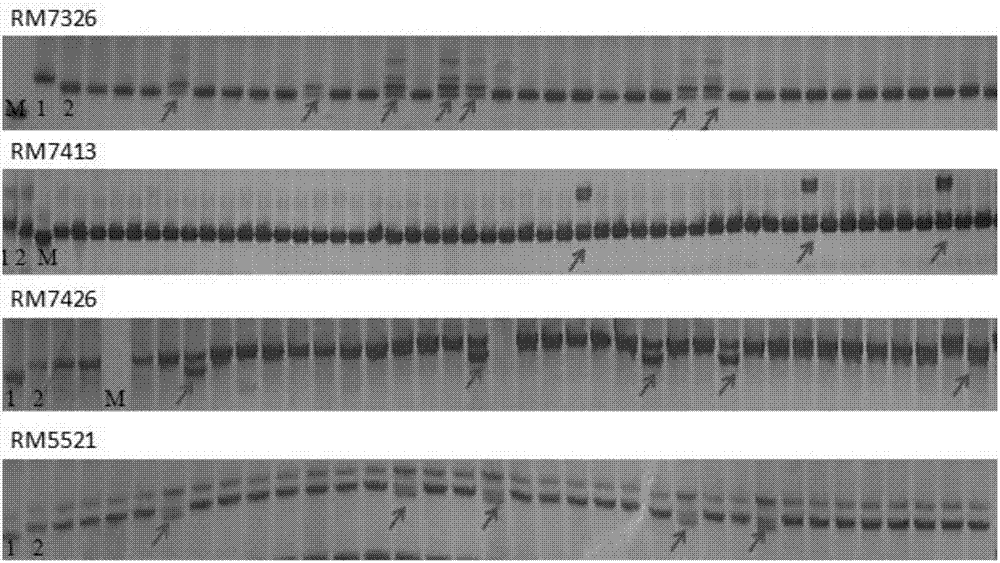Method for cultivating japonica rice varieties resistant to herbicide imazethapyr assisted by molecular marker
A molecular marker-assisted, herbicide-resistant technology, applied in biochemical equipment and methods, microbial measurement/inspection, etc., can solve problems such as economic loss, affecting crop growth and development, reducing crop yield, quality, etc., to achieve accuracy and simplify The effect of the process
- Summary
- Abstract
- Description
- Claims
- Application Information
AI Technical Summary
Problems solved by technology
Method used
Image
Examples
Embodiment 1
[0039] Example 1. Acquisition of SSR Molecular Marker RM7413 Linked to Imazethapyr Herbicide Resistance in Japonica Rice
[0040] The research team of the present invention screened out an imazethapyr-resistant rice material "Jinjing 818" from 7403 rice variety resource materials. The variety Jinjing 818 was identified to be resistant to the herbicide imazethapyr, but its genetic mechanism was unknown. Therefore, the genetic mechanism of this variety was first studied and the resistance gene mapping was carried out.
[0041] 1) Genetic analysis of the herbicide imazethapyr resistance of Jinjing 818
[0042] The japonica rice variety Jinjing 818 resistant to the herbicide imazethapyr was used as a donor and the popularized japonica rice variety Suken 118 sensitive to the herbicide imazethapyr was used as a recipient to obtain F 1 10 plants, to F 1 When the generation seedling grows to 2 leaves and 1 heart, the recommended concentration of imazethapyr is 70g ai ha -1 Spray scre...
Embodiment 2
[0052] Example 2. Application of Molecular Markers in Assisted Breeding of Imazethapyr-resistant Japonica Rice Varieties
[0053] 1) The present invention uses the imazethapyr-resistant variety Jinjing 818 as the donor parent, and the imazethapyr-sensitive Nanjing 9108 as the recipient parent. Both parents are currently the main popularized varieties with good yield and adaptability. The two parents were crossed and combined to harvest F 1 generation seeds.
[0054] 2)F 1 F 2 Generation seeds, planted F 2 50 seeds, get F 2 Substitute plants. Leaves were taken from each individual plant, DNA was extracted, and the SSR marker RM7413 in Example 1 was used for amplification. The amplification system, conditions and detection methods were the same as those shown in Example 1. Select a single plant that is completely consistent with the band pattern of the resistant parent.
[0055] 3) Change F 2 Generationally selected plants were continuously selfed to F 7 At the same tim...
Embodiment 3
[0056] Example 3. The application potential of the marker RM7413 linked to the herbicide-resistant imazethapyr in japonica rice in the currently popularized japonica rice varieties
[0057] Conventional japonica rice varieties usually do not have the ability to resist the herbicide imazethapyr. If the marker RM7413 has the polymorphisms in Examples 1 and 2 in the herbicide-sensitive conventional japonica rice variety and the resistant variety Jinjing 818, then RM7413 can be used in conventional japonica rice varieties. Improvement of herbicide resistance in japonica rice to obtain new herbicide-resistant varieties. The present invention selects 91 japonica rice varieties mainly popularized in the middle and lower reaches of the Yangtze River for polymorphic identification, and uses the SSR marker RM7413 in Examples 1 and 2 to amplify, and the amplification system, conditions and detection methods are the same as those shown in Example 1 . The identified varieties include Lian...
PUM
 Login to View More
Login to View More Abstract
Description
Claims
Application Information
 Login to View More
Login to View More - R&D
- Intellectual Property
- Life Sciences
- Materials
- Tech Scout
- Unparalleled Data Quality
- Higher Quality Content
- 60% Fewer Hallucinations
Browse by: Latest US Patents, China's latest patents, Technical Efficacy Thesaurus, Application Domain, Technology Topic, Popular Technical Reports.
© 2025 PatSnap. All rights reserved.Legal|Privacy policy|Modern Slavery Act Transparency Statement|Sitemap|About US| Contact US: help@patsnap.com



